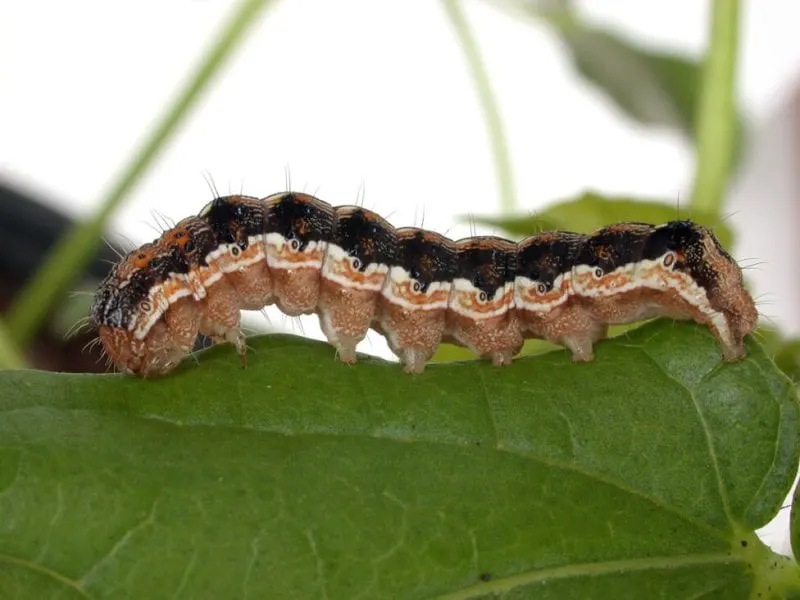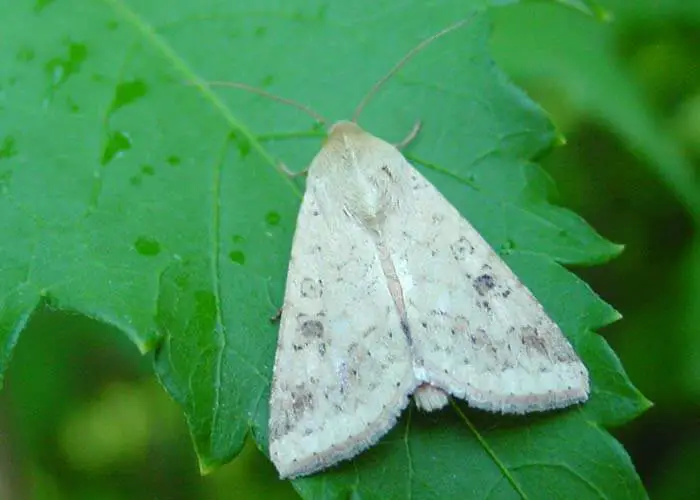GM plant grows insect sex pheromones as alternative to crop pesticides
GM plant grows insect sex pheromones as alternative to crop pesticides


Pheromones and other semiochemicals are among the next generation of sustainable insect controls. They protect crops by repelling pest insects from plants, preventing them from mating or otherwise manipulating their behaviors. This approach protects the environment, while eliminating the problems of insecticide residues on food and insects developing resistance to pesticides.
Currently, insect sex pheromones are produced synthetically — a costly process that uses either petroleum or plant oils as feedstock to provide the hydrocarbon chains to build upon. Large volumes of solvents are also needed to create intermediary compounds, resulting in chemical waste byproducts. By starting instead with precursors in the GM seed oil, researchers are able to eliminate most of the solvent needs and about 80 percent of the chemical waste. Using the oil-rich camelina plant as a “biofactory” also significantly shortens the process and reduces the high cost of producing pheromones.
The revolutionary research is being done by ISCA, Inc., a “green” agricultural technology company based in Riverside, Calif., in collaboration with Lund University in Sweden.
“Pheromone controls are the future of crop protection, and ISCA’s breakthrough biological pheromone synthesis will propel agriculture into a more lucrative and sustainable enterprise,” said ISCA CEO Agenor Mafra-Neto. “Efficacious pheromone controls are badly needed, especially now that global agriculture faces increasing pest resistance that renders conventional insecticides less effective and increasing pressure from governments and consumers demanding ever safer and greener food production.”

Researchers from Lund University, Swedish Agricultural University and SemioPlant (a startup created by the researchers) modified the genetic code of camelina (Camelina sativa) plants to include genes of insects and other organisms that guide the formation of the desired pheromones. The plants produce insect pheromone precursor compounds in their abundant seed oil. Their work builds on the extensive research on moth pheromone biosynthesis that initiated in the research group of Prof. Wendell Roelofs at Cornell’s New York State Agricultural Experiment Station (now known as Cornell AgriTech) in the early 1980s.
ISCA grew successive generations of the transgenic camelina plants and developed a prototype product with plant-derived pheromones to control the cotton bollworm moth (Helicoverpa armigera), a major world pest species that causes hundreds of millions of dollars annually in damage to cotton, corn, tomato, chickpea and other crops.

Using camelina to create low-cost sources of insect pheromones is expected to boost mating disruption controls for several devastating moth species. In nature, the female moths release a species-specific sex pheromone to call males for mating. Applying the same pheromone in the field creates thousands of scent trails that lead nowhere, preventing males from finding mates. Since the females lay sterile eggs, the crops are protected from the damage that would otherwise occur when the caterpillars hatch and begin eating.
Results from an initial trial in Brazil showed that the ISCA formulation with plant-derived pheromones performed just as well as a formulation made with synthetic pheromones. Both suppressed H. armigera populations in bean fields by preventing adult moths from mating. ISCA is also developing plant-derived pheromone controls for the fall armyworm, Spodoptera frugiperda, another devastating moth species that in recent years has begun causing extensive crop damage in Africa and India. The company plans additional trials in Brazil and is also looking to do trials in the United States.
“In collaboration with ISCA, we hope to develop new lines to target several other important pests,” said research leader and Lund University biology Prof. Christer Löfstedt. Lund has also genetically modified tobacco plants to produce insect pheromones.
The US Department of Agriculture’s (USDA) National Institute of Food and Agriculture (NIFA) has awarded ISCA two grants totaling $750,000. The most recent award supports ISCA’s ongoing efforts to develop transgenic camelina strains that produce the sex pheromones of other moth pest species and corresponding sustainable pest control products.
Under the terms of the USDA grant, ISCA must complete its research and development work by September 2022 and then be ready for commercialization. The plant-derived pheromones could be on the market by 2023. However, ISCA officials noted that they “are basically in uncharted territory in terms of regulatory approvals needed for commercialization. While the plant-derived sex pheromones are chemically the same as synthetic pheromones made from standard industrial processes, they will still be by-products of GMO plants. To help us navigate the regulatory path, our Phase 2 USDA grant includes $50,000 for technical and business assistance. This assistance will help us determine our path for commercialization, and where we start.”
The company is already marketing a number of pheromone products, including a formulation to control noctuid moths on row crops in Latin America, a mating-disruption control for the gypsy moth that the US Forest Service is using in 10 states, a mating-disruption control for grapevine moth used in vineyards in Argentina, a repellent for bark beetles that is protecting conifer trees in western North America, a fruit fly control protecting mangoes in West Africa and a honeybee attractant that increases pollination rates.
Joan Conrow has more than 35 years of experience as a journalist and editor. She specializes in environmental issues, biotechnology, and agriculture, and is especially interested in how these highly charged topics are playing out globally. Joan holds a BA in history and journalism and is certified in beekeeping, mediation, and facilitation. Find Joan on Twitter @joanconrow
A version of this article was originally posted at the Cornell Alliance for Science and has been reposted here with permission. The Cornell Alliance for Science can be found on Twitter @ScienceAlly

 | Videos | More... |

Video: Nuclear energy will destroy us? Global warming is an existential threat? Chemicals are massacring bees? Donate to the Green Industrial Complex!
 | Bees & Pollinators | More... |

GLP podcast: Science journalism is a mess. Here’s how to fix it

Mosquito massacre: Can we safely tackle malaria with a CRISPR gene drive?

Are we facing an ‘Insect Apocalypse’ caused by ‘intensive, industrial’ farming and agricultural chemicals? The media say yes; Science says ‘no’
 | Infographics | More... |

Infographic: Global regulatory and health research agencies on whether glyphosate causes cancer
 | GMO FAQs | More... |

Why is there controversy over GMO foods but not GMO drugs?

How are GMOs labeled around the world?

How does genetic engineering differ from conventional breeding?
 | GLP Profiles | More... |

Alex Jones: Right-wing conspiracy theorist stokes fear of GMOs, pesticides to sell ‘health supplements’




 Trust issues: What happens when therapists use ChatGPT?
Trust issues: What happens when therapists use ChatGPT? Fighting deforestation with CO2: Biotechnology breakthrough creates sustainable palm oil alternative for cosmetics
Fighting deforestation with CO2: Biotechnology breakthrough creates sustainable palm oil alternative for cosmetics California, Washington, Oregon forge immunization alliance to safeguard vaccine access against federal undermining
California, Washington, Oregon forge immunization alliance to safeguard vaccine access against federal undermining Viewpoint — Fact checking MAHA mythmakers: How wellness influencers and RFK, Jr. undermine American science and health
Viewpoint — Fact checking MAHA mythmakers: How wellness influencers and RFK, Jr. undermine American science and health 30-year-old tomato line shows genetic resistance to devastating virus
30-year-old tomato line shows genetic resistance to devastating virus Viewpoint: Video — Big Solar is gobbling up productive agricultural land and hurting farmers yet providing little energy or sustainabilty gains
Viewpoint: Video — Big Solar is gobbling up productive agricultural land and hurting farmers yet providing little energy or sustainabilty gains The free-range chicken dilemma: Better for birds, but with substantial costs
The free-range chicken dilemma: Better for birds, but with substantial costs ‘You have to treat the brain first’: Rethinking chronic pain with Sanjay Gupta
‘You have to treat the brain first’: Rethinking chronic pain with Sanjay Gupta
